
Variable With Swingweight
(View Shot Inputs)
- Incident Ball
- Velocity = 25 mph
- Spin = 3,000 rpm topspin
- Angle = Horizontal (top of bounce)
- Incident Swing
- Swing Angle = 19 degrees upward
- Racquet tilt = 10 degrees forward
- Swing speed (2 choices)
- All racquets swung with same effort as 310 swingweight at 50 mph (default)
- All racquets swung at 50 mph
- Impact Location
- Impact point = 21 inches from butt
- 2 inches off-center (default)
- On-center
STEP 1 — Power
[Note: The difference between racquets for a particular performance parameter can differ radically depending on the settings in "Player Variables" in the Control Panel. To find out how and why, click the question mark next to the dropdown choices for an explanation.]
The power of the racquet is not a measure of the final shot speed but rather of the racquet's contribution to that speed — the bounce speed. Bounce speed plus swing speed equals shot speed.
To determine bounce speed, we must first determine the power potential ratio (also known as ACOR, the apparent coefficient of restitution). This is determined in the lab by firing balls at a stationary racquet. The ratio of the ball's rebound speed to the impact speed is the power potential (usually expressed as a percentage). The bounce speed is then calculated as the power potential times the collision speed (sum of incident ball speed plus racquet speed).
Power potential is a property of the racquet but it is different at every location on the stringbed. We have measured this at 13 locations and use only two typical impact locations (Figure 1 below) for the calculations in this tool — on-center at 21 inches from the butt, and off-center 2 inches to either side of the center location. Power potential is so important because it is the net result of every single characteristic, spec, and use of the racquet. As such, and because most performances follow from it (control, comfort, plow-through, shot speed, swing speed, launch angle, distance, etc.), it could very well be called the "performance potential."
Key Points
1. The amount of mass and its distance from the axis of rotation (both lengthwise and widthwise) are the main determinants of power.
2. Mass distribution determines shot speed in two ways: the bounce speed from the racquet and the swing speed of the racquet.
3. Mass distribution from butt to head is measured via swingweight.
4. Mass distribution on the head periphery toward 3 and 9 o'clock is measured by twistweight — i.e., resistance to twisting rotation.
5. More mass towards the tip and 3 and 9 o'clock always produces more power (though not necessisarily more shot speed). If the swing effort remains the same, as power potential increases, swing speed decreases. Shot speed will be the net effect. If swing speed is kept constant (with more effort), shot speed will always be greater if power potential is greater.
6. Together, swingweight and twistweight determine the hittingweight (see spec table). This varies at each impact location and it is the "effective" mass at that point. Hittingweight uniquely determines the response of each impact location to collision with the ball.
7. The scatter in the power dots at each swingweight (x axis) is due to each racquet's twistweight and stiffness (vibration). There is less scatter for on-center hits because twistweight is not a factor. There is also less scatter for same speed swings because that eliminates the influence of swingweight on swing speed and the resulting shot speed.
Figure 1: Example of power potential across stringbed for two racquets compared at each location.
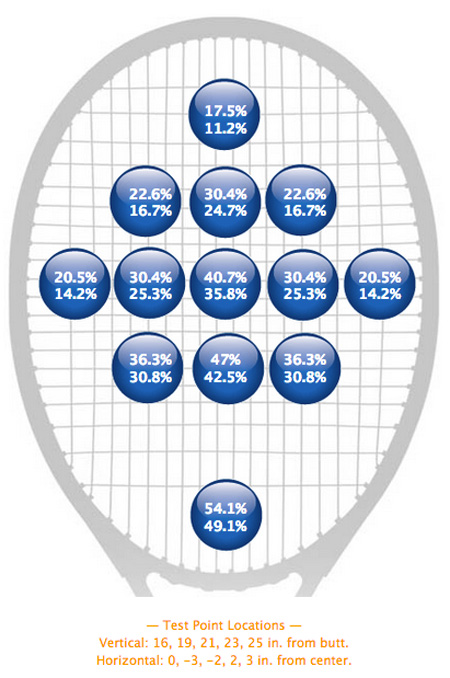
STEP 2 — Power Zone Size
[Note: The difference between racquets for a particular performance parameter can differ radically depending on the settings in "Player Variables" in the Control Panel. To find out how and why, click the question mark next to the dropdown choices for an explanation.]
1. The power zone is also known as the sweet zone and is the area above 19 inches from the butt in which the power potential is greater than or equal to 30%. In other words, it is the area from which the ball will bounce from the racquet with at least 30% of it's incident speed. In the diagram below, this is indicated by the all the area above the horizontal 19-inch line and inside the blue line (including inside the green line).
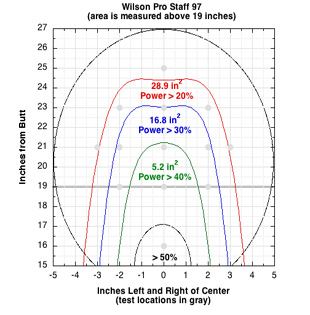
2. Power zone size depends most on swingweight and twistweight. Higher swingweight extends the zone upward and higher twistweight extends it outward.
3. Larger headsizes will naturally tend to have larger power zones because the mass is located further from the center line of the racquet. Location of mass is more important to swingweight and twistweight than is the amount of mass. These both vary with the square of distance and linearly with mass.
4. A larger power zone is associated with a more stable and comfortable shot on off-center impacts.
STEP 3 — Swing Speed
[Note: The difference between racquets for a particular performance parameter can differ radically depending on the settings in "Player Variables" in the Control Panel. To find out how and why, click the question mark next to the dropdown choices for an explanation.]
1. Two choices of swing speed are available — (1) all racquets swung at 50 mph, and (2) all racquets swung with the same effort as swinging a 310 swingweight racquet at 50 mph. Thus, the same effort swings applied to varying swingweights will produce varying swing speeds. The same swing speed with all swingweights will require different efforts.
2. When all racquets are swung at 50 mph, the only difference in shot speed will be determined by the racquet's power potential measurement (ACOR).
3. When all racquets are swung at the same effort, swing speed will decrease with added swingweight and increase with decreasing swingweight. But power increases with added swingweight and decreases with lower swingweight. The two trends tend to cancel each other and shot speed will be the net result, reflecting both the racquet's effect on the ball and on the player.
STEP 4 — Spin
[Note: The difference between racquets for a particular performance parameter can differ radically depending on the settings in "Player Variables" in the Control Panel. To find out how and why, click the question mark next to the dropdown choices for an explanation.]
1. The most important ingredient in spin is the relative speed of the strings to the ball in a plane parallel to the stringbed.
2. This speed is affected by swing speed, angle of swing, racquet tilt and the direction of the ball (rising, falling, or horizontal). These affect how fast the strings slide past the ball. All these are fixed in the tool except swing speed.
3. For same effort swings, as swingweight increases, swing speed decreases and spin therefore also decreases. If the swing speed is kept constant, then the spin will be the same for all racquets.
4. The spread over all racquets in spin for a same effort swing was 120 rpm, or 8.1%.
5. Loss in spin due to increased swingweight may be minimized by choosing an open string pattern or a string with high spin potential. Further, as shown here, hitting in the lower half of the racquet will increase spin. These are not directly factored into this analysis.
STEP 5 — Plow-Through
[Note: The difference between racquets for a particular performance parameter can differ radically depending on the settings in "Player Variables" in the Control Panel. To find out how and why, click the question mark next to the dropdown choices for an explanation.]
1. Plow-through is a measurement of the change in momentum of the racquet's impact point during impact.
2. Because momentum = mass x velocity and mass remains the same during the swing, plow-through is measuring change in velocity during impact. Mass is the effective mass, or hittingweight. This is calculated separately for each impact location. An example of how hittingweight changes by location is shown for two racquets in the Figure 1 below.
3. Velocity decreases due to recoil and both lengthwise and widthwise rotation. Hence, plowthrough depends on hittingweight, swingweight, twistweight and pre-impact velocity.
4. As calculated here, plow-through is the percentage of initial velocity remaining immediately after impact at the precise impact location. It can actually be negative (due to backward recoil, twist, rotation, and bending). Figure 2 shows an example of plow-through for two racquets at various impact locations.
5. The change in velocity is an indication of the severity of shock during impact. Higher plow-through indicates less shock, more stability, and more comfort.
Figure 1: Example of hittingweights across stringbed for two racquets compared at each location.
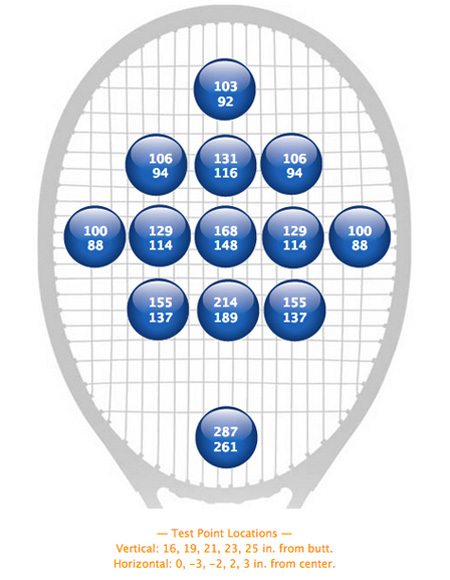
Figure 2: Example of plow-through across stringbed for two racquets compared at each location.
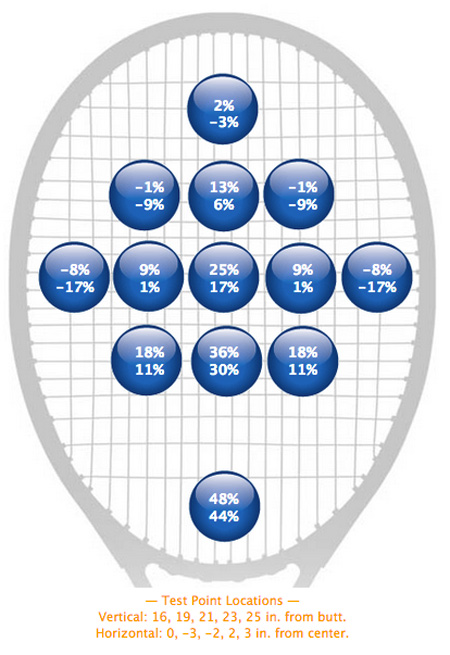
STEP 6 — Shot Speed
[Note: The difference between racquets for a particular performance parameter can differ radically depending on the settings in "Player Variables" in the Control Panel. To find out how and why, click the question mark next to the dropdown choices for an explanation.]
1. For same effort swings, as swingweight is increased swing speed decreases and power increases.
2. Since shot speed depends on both swing speed and racquet power, the result will depend on whether the increase/decrease effect of one out weighs the decrease/increase effect of the other.
3. The result also depends on whether the impact is on-center or off-center. Twistweight comes into play on off-center hits — higher twistweight yielding greater shot speeds (hence more scatter in the graph). For on-center hits, twistweight is not a factor and shot speed is influenced only by swingweight and its affect on swing speed and power potential (ACOR) (hence less scatter in the graph).
4. For same speed swings, shot speed will be influenced only by power potential as influenced by twistweight (for off-center hits) and swingweight (for both on-center and off-center hits).
5. On-center hits were always faster than off-center hits (for hits at the same distance from the racquet end — 21 inches here).
STEP 7 — Launch Angle
[Note: The difference between racquets for a particular performance parameter can differ radically depending on the settings in "Player Variables" in the Control Panel. To find out how and why, click the question mark next to the dropdown choices for an explanation.]
Launch angle decreases with an increase in swingweight, and increases with a decrease in swingweight. This is illustrated in figures 1-4. In each of the following figures, the swing speed (v swing) is added to the bounce speed (v bounce) to obtain the resulting shot speed (v shot) and angle. The relative velocities are shown as the lengths of the respective arrows (though not shown to scale and meant only for illustration purposes). Bounce speed is determined as explained in "Power Help".
Note: The following figures are also used to help explain the differences in distance, time, angle, and shot speed.
1. The ball impacts the racquet at the top of the bounce travelling horizontal to the court and perpendicular to the racquet. The ball has top spin relative to the court, which is backspin relative to the racquet, and thus bounces up with reversed spin.
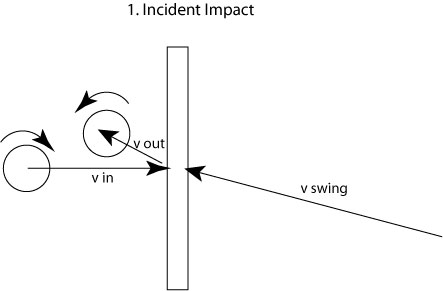
2. The ball will rebound with the same speed parallel to the racquet with both low and high swingweight racquets, but the perpendicular speed ("bounce speed") will vary with swingweight. The low swingweight racquet will have a lower power, lesser bounce speed, faster swing, and higher launch angle. The ball will also travel farther and have a longer flight time.
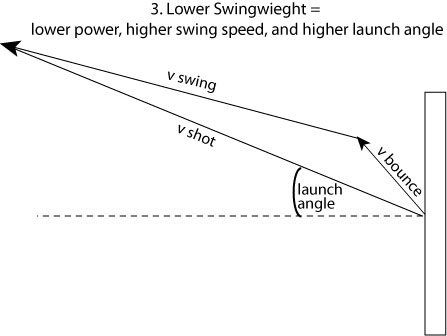
3. The high swingweight racquet will have more power, greater bounce speed, slower swing and lower launch angle. The distance will usually be less and flight time shorter.
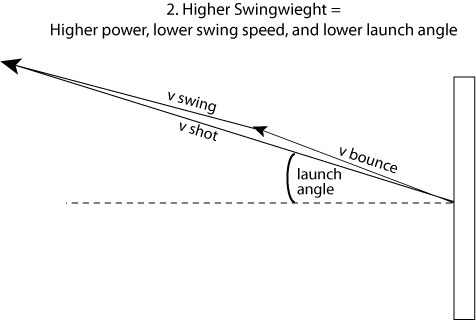
4. The side-by-side comparison is shown in figure 4.
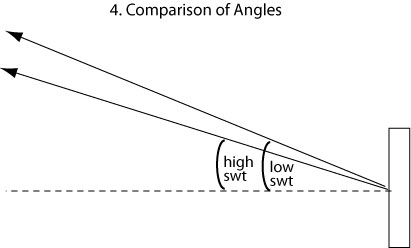
5. The shot speed will vary depending on the net effect of the increasing/decreasing of power and the decreasing/increasing of swing speed. However, the launch angle has a greater influence on distance than speed, so the ball hit with the lower swingweight racquet at higher launch angle will usually travel farther than the ball hit with the higher swingweight racquet (the actual result will depend on whether you hit on center or off center as described in the "Distance Help" section.
STEP 8 — Shot Distance
[Note: The difference between racquets for a particular performance parameter can differ radically depending on the settings in "Player Variables" in the Control Panel. To find out how and why, click the question mark next to the dropdown choices for an explanation.]
1. Distance increases with both shot speed and launch angle. But, shot speed increases with swingweight and launch angle decreases. As a result, as swingweight increases, shot speed works to increase distance and launch angle to decrease it. The net effect is to decrease distance on same effort hits and slightly increase it for same swing speed hits.
This is illustrated in figures 1-4. In each of the following figures, the swing speed (v swing) is added to the bounce speed (v bounce) to obtain the resulting shot speed (v shot) and angle. The relative velocities are shown as the lengths of the respective arrows (though not shown to scale and meant only for illustration purposes). Bounce speed is determined as explained in "Power Help".
1. The ball impacts the racquet at the top of the bounce travelling horizontal to the court and perpendicular to the racquet. The ball has top spin relative to the court, which is backspin relative to the racquet, and thus bounces up with reversed spin.

2. The ball will rebound with the same speed parallel to the racquet with both low and high swingweight racquets, but the perpendicular speed ("bounce speed") will vary with swingweight. The low swingweight racquet will have a lower power, lesser bounce speed, faster swing, and higher launch angle. The ball will also travel farther and have a longer flight time.

3. The high swingweight racquet will have more power, greater bounce speed, slower swing and lower launch angle. The distance will usually be less and flight time shorter.

4. The side-by-side comparison is shown in figure 4.

5. The shot speed will vary depending on the net effect of the increasing/decreasing of power and the decreasing/increasing of swing speed. However, the launch angle has a greater influence on distance than speed, so the ball hit with the lower swingweight racquet at higher launch angle will usually travel farther than the ball hit with the higher swingweight racquet (the actual result will depend on whether you hit on center or off center as described in the "Distance Help" section.
STEP 9 — Flight Time
[Note: The difference between racquets for a particular performance parameter can differ radically depending on the settings in "Player Variables" in the Control Panel. To find out how and why, click the question mark next to the dropdown choices for an explanation.]
1. As swingweight increases shot speed increases, launch angle decreases, and distance decreases (for same effort swings), so time in the air naturally decreases.
2. As swingweight decreases, the opposite occurs: shot speed can be faster or slower (generally slower), launch angle higher, distance longer, so flight time is also longer.
This is illustrated in figures 1-4. In each of the following figures, the swing speed (v swing) is added to the bounce speed (v bounce) to obtain the resulting shot speed (v shot) and angle. The relative velocities are shown as the lengths of the respective arrows (though not shown to scale and meant only for illustration purposes). Bounce speed is determined as explained in "Power Help".
1. The ball impacts the racquet at the top of the bounce travelling horizontal to the court and perpendicular to the racquet. The ball has top spin relative to the court, which is backspin relative to the racquet, and thus bounces up with reversed spin.

2. The ball will rebound with the same speed parallel to the racquet with both low and high swingweight racquets, but the perpendicular speed ("bounce speed") will vary with swingweight. The low swingweight racquet will have a lower power, lesser bounce speed, faster swing, and higher launch angle. The ball will also travel farther and have a longer flight time.

3. The high swingweight racquet will have more power, greater bounce speed, slower swing and lower launch angle. The distance will usually be less and flight time shorter.

4. The side-by-side comparison is shown in figure 4.

5. The shot speed will vary depending on the net effect of the increasing/decreasing of power and the decreasing/increasing of swing speed. However, the launch angle has a greater influence on distance than speed, so the ball hit with the lower swingweight racquet at higher launch angle will usually travel farther than the ball hit with the higher swingweight racquet (the actual result will depend on whether you hit on center or off center as described in the "Distance Help" section.
Terms and Definitions
Power Potential: It measures the combined performance effect of every property of the racquet ...
... It is a ratio as percentage of the ball velocity caused by the racquet (not by the speed of the swing) to the combined impact speed of the ball and racquet. The racquet's contribution to ball speed is known as "bounce speed" and can be caluculated as the ball speed minus the racquet speed at the impact point. This ratio is also known as ACOR (apparent coefficient of restitution). Power potential can be measured anywhere on the racquet (TWU measures 15 locations), but for comparison purposes we compare at 21 in. from butt and 2 in. off-center. A high power potential means that impact causes less recoil, twist and bend, thus resulting in more power, control, and comfort. The downside is less maneuverability. Power potential derives primarily from the amount and distribution of mass, both lengthwise and widthwise — farther from the axis of rotation increases power potential (see swingweight and twistweight). Like sweet zone, the power potential is a performance measurement, not simply a static property characteristic.
Power or Sweet Zone: This is the area in square inches (above 19 inches) where power potential is greater than or equal to 30% ...
... TWU delineates 3 sweet zones: 20%, 30% and 40%, but for comparison purposes we report the 30% area. As such, it is a topographical map of power potential across the racquet face. The size of the sweet zone area is the result of all racquet properties as they combine to launch the ball from each location. Like power potential, the sweet zone is a performance measurement, not simply a static property characteristic. However, it is primarily determined by amount and distribution of mass.
Hittingweight: This is the effective mass of the racquet at the hitting location ...
... The distribution of the total mass of the racquet will determine how much mass comes into play at each impact location on the racquet. Hittingweight is always less than the weight of the racquet. As a rule of thumb, impact near the tip will be about one third the acutal weight, near the center will be one-half, and at the balance point would be the actual weight, the the acutal value will depend on the racquet. Some racquets can actually have less effective mass close to the periphery than the mass of the ball (about 57 g). Higher hittingweight means more power, stability, and comfort.
Plow-Through: This is a measure of how much hitting location velocity remains just after impact ...
. . . During impact the hitting location decelerates by recoiling, twisting and rotating backward. These three decelerations can, just for a instant, significantly decrease the hitting location velocity, sometimes to near zero or negative velocities. This deceleration increases as you hit toward the tip or to the peripehry of the stringbed. Higher plowthrough means the hitting location maintained a higher speed and your arm experienced less of a jolt. These events occur in less than 5 m/s and cannot be seen without a high speed camera, but they can be felt. Less jolt is experienced as high plow-through, "crushing" the ball, a solid hit. As dramatic as such statements sound, the impact location will almost always retain less than 50% of its velocity.
Swingweight: It is a measurement of the resistance of the racquet to being accelerated in a circular swing ...
... This is a so-called dynamic test since the racquet must be swung to make the measurement (as opposed to static weight or balance measurements). Swingweight is a double-edged sword. More mass spread out toward the head creates more power, stability and comfort because the ball's effect on racquet momentum and direction is limited. At the same time, more mass toward the head requires more effort to generate swing speed. Swingweight can be measured about any axis perpendicular to the racquet length and parallel to the racquet face. Common swingweight machines measure it about an axis 4 in (10 cm) from the butt.
Twistweight: This is the resistance of the racquet to twisting (rotating about the lengthwise axis) ...
... It is the same physical measurement as swingweight but about the racquet's lengthwise axis instead of one perpendicular to it. Twistweight is primarily concerned with the distribution of mass from the middle of the racquet out to the periphery of the racquet head. The more mass located at further distances (e.g. 3 and 9 o'clock), the more difficult it is for the ball to twist the racquet on off-center hits, thus providing more stability, power, comfort and control. As such, twistweight is an important component in the sweet zone measurement.
Balance: This is the location along the length where the racquet will balance on a straight edge ...
... It too is a measurement that indicates distribution of mass, but it is far less reliable for predicting performance than swingwight, twistweight, hittingweight and power potential — because you can have a high balance and low swingweight or low balance and high swingweight. The balance point does not always reflect the continuum of mass distribution. Balance is best used as tie-breaker after you have decided upon power potential or swingweight. It can be customized with lead tape to alter the feel and perception of the racquet without significantly altering the performance (see TWU customization tools: Customization Tool and Customization Worksheet).
Weight: This is the total weight of the racquet as measured on a scale ...
... This is probably the most universal and most paid-attention-to spec, not because it is most important, but because it is most familiar and easiest to measure. Mass is most important for how much there is to distribute as well as to structure. Its magnitude alone may or may not be important, depending on how it is distributed, as reflected in swingweight, twistweight, hittingweight, and power potential. However, since racquets are generally so similarly constructed and marketed, heavy racquets usually indicate high swingweight and power potential and light racquets less of these. This is not because of physical necessity but because of convention.
Vibration Frequency: This is the vibration frequency in cycles per second of the racquet ...
... Vibration is a measurement of rate of bending in a certain direction — as in the racquet head bending backward on impact. The vibration frequency is the same at all points along a racquet. The bend begins at the impact point and moves up and down the racquet. High frequency (more "back-and-forths" per second) indicates higher stiffness, less bending distance, and less energy loss, but more shock. Low frequency indicates lower stiffness, more bending, more energy loss and less shock. A high frequency racquet transfers less bending energy to the hand, but more rotational energy in the form of very short impulse shock. The lower frequency racquet will will deliver more bending energy to the hand, but less shock, since this energy transfer takes place over a longer distance and time.
Instructions
The instructions are simple: click on everything and anything that looks like a button or menu. Each click leads to new data, explanations, and information. Some of the clicks below don't appear until others have first been clicked.
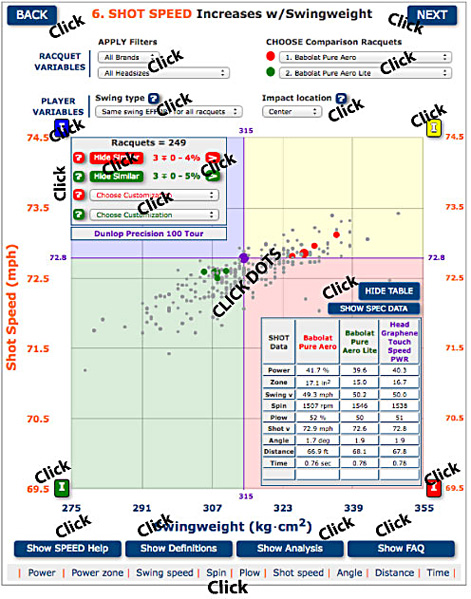
Frequently Asked Questions (FAQ)
∨ 1. What are the assumptions for the shot used in all the graphs?
The analysis is based on an incident ball speed of 25 mph with spin of 3,000 rpm and hit at the top of the bounce, a swing angle of 19 degrees upward from horizontal, and racquet tilt of 10 degrees forward from vertical. The impact point is 21 inches from the butt end and either on-center or 2 inches off-center. The drag coefficient is 0.51. Two choices of swing speed are available — (1) all racquets swung at 50 mph, and (2) all racquets swung with the same effort as swinging a 310 swingweight racquet at 50 mph. Thus, the same effort swings applied to varying swingweights will produce varying swing speeds. The same swing speed with all swingweights will require different efforts. Both assumptions are necessary to reflect both theory and practice.
∨ 2. Why is swingweight on the horizontal axis in every graph?
Swingweight is the only racquet parameter that has a strong correlation to every performance result. It is the one spec that will give some hint at what the overall performance characteristics of the racquet will be. The strong correlation is witnessed by the fact that all the dots on the graphs can be fitted to a straight or curved line.
∨ 3. Why are the similar racquets sometimes located far away from the reference racquet in some of the graphs?
Specs of and by themselves do not tell you what the performance will be — they are more descriptive than predictive or behavioral. Performance is the result of the combination of all the specs. This tool graphs performance results, not descriptive possibility. Similar racquets may be close in all specs, say within 5%, but then each variant spec will combine with all the others in ways that may be behaviorally quite different.
∨ 4. How are similar racquets chosen?
All the specs listed in each graph's comparison table are compared to the reference racquet. The program first checks for 1% matches, then 2%, then 3%, etc., up to 10% for all racquets. If the result is +/1 4%, for example, that means that all 10 spec parameters for a racquet are similar within 4%. These limits guarantee that 1-10 (or so) most similar racquets will be highlighted. The racquets found will be in the range designated at the top of the graph (e.g., "4 similar ∓ 0-8%"). If the brand or spec filters have been applied, there are fewer racquets to choose from so the "similars" generally become less similar.
∨ 5. Why were the two hitting locations chosen?
The off-center hitting location was chosen for two reasons: first, most shots are hit off-center at least a little, and more importantly, off-center hits bring more racquet parameters into play such as twistweight, power zone size, plow-through, and vibration. The off-center graphs will tell you how the racquet behaves on average. The on-center hits will tell you about the ideal performance of the racquet. On-center hits are less frequent and one spec alone stands out as influencing performance — swingweight.
∨ 6. What is the best way to look at and interpret the data?
The graphs are meant to give an immediate visual representation of where each racquet stands in relation to every other racquet for the given performance category. Any two particular racquets can be chosen from the brand filters and a third random or positional racquet chosen by clicking on a dot on the graph. This presentation contextualizes every racquet in relation to all others and individually to each other.
∨ 7. What happens if I swing harder?
On any given shot, you can always swing harder. Perhaps you can even do this on every shot. If that is the case and it feels good to you, then adding swingweight will always increase shot speed and spin from your previous situation. Comfort may still be a tradeoff because even though you have a more stable racquet with the higher swingweight, the force of impact will be greater due to your faster swing.
∨ 8. Why isn't control included as one of the performance measurements?
We have not done specific experiments to determine control. It is to be expected that off-center hits will twist the racquet, launching the ball either higher or lower. The launch angle graphs presently describe the effect of change in angle due to changes in the ratio of horizontal and vertical velocity components, not to twisting of the racquet. Control will thus be a future add-on to the tool.
∨ 9. Why are the TWU specs often different than the TW specs?
Like all products, racquets are manufactured such that each feature/property specification has a plus-minus range of acceptability. For racquets, that can be anywhere from +/- 2-5%. If it is 5%, then a racquet with a swingweight spec of 300 could acceptably come in from 285-315 kg x cm2 and balance spec of 33 could be 31.4-34.6 cm. At 2% swingweight would be 294-306 and the balance would be 32.3-33.7 cm.
To complicate matters more, the specs you see in advertising may be the target spec, the measured spec of just one sample racquet, or the average of several randomly chosen racquets. These may all differ.
That being said, specs in themselves have become over-emphasized. One reason is that performance measurements and calculations for every racquet are difficult, so descriptive "spec" measurements are used instead. Specs are deemed important because it is thought that each correlates to a performance benefit, need, or want. This might be true in a controlled "everything else being equal" world, but that is never the case.
Performance is the combined product of all the specs, not the isolated result of a single spec. That is why we measure and calculate the combined result — the actual performance. What one spec giveth another taketh away. What matters in the end is the combined result in both performance and feel.
Swingweight Affects Swing Speed
Swingweight affects swing speed, but how much and in what direction depends on the player. We examine two main possibilities — swinging with the same perceived effort and swinging at the exact same speed with each racquet.
Swing with same effort. Swinging with the same effort will result in different swing speeds for different swingweight racquets and thus performance measurements such as ball speed, distance, launch angle, and spin will vary accordingly. In this case, the shot results are a consequence of the racquet all by itself. This is the default value because our main objective is to compare and analyze racquets.
Swing at same speed. The second swing choice is to swing at the same speed for every racquet. This means that the player will automatically raise or lower his or her effort in order for the swing speed to be the same for each racquet. This reflects what some players might do to achieve their "grooved" swing preference and feel. The shot results from this analysis will thus be the results of both a change in racquets and player behavior. This is important to determine how a player may or may not potentially benefit from a racquet change.
Swing speed is the racquet speed at the point of impact. The target speed for all calculations is 50 mph.
Impact Location
Two choices are offered to demonstrate the influence of all the key racquet variables in shot performance. Both off-center (2 inches) and on-center hits are examined.
Off-center Impacts. Off-center hits are the default because they are influeced by more racquet variables than are on-center hits. Most players, either purposely or not, do not hit on center, and all the racquet's properties are then important. The main properties that influence off-center and not on-center hits are twistweight and vibration frequency (stiffness). Higher twistweight and frequency both add to power, and lower of each decreases it.
On-center Impacts. Any hit along the central racquet length is not influenced by twistweight. Also along this length there are two locations known as nodes, which if hit, do not initiate longitudinal racquet bending and vibration. Depending on the racquet, the center of the racquet is close to one of these nodes, the effect of vibration will be minimized, though usually not totally (hoop vibrations are not minimized however, though these don't affect shot speed much if any).
Because the results of off-center hits are influenced so heavily by twistweight and vibration frequency, there will be much more variation and scatter on the graph between racquets. On center, the racquet plots will be much tighter with less scatter.
An Example. As a case in point, if you choose same swing effort and off-center impact for the shot speed graph, you will see a lot of scatter. Choose one vertical swingweight line — if you click the top dot (fastest shot) and look at the twistweight (twt) in the table, and then click on the lowest dot, you will see that the twistweight is hightest for the fastest shot and lowest for the slowest shot.
If you now click instead on the center impact choice, the graph will tighten. If you do the same dot clicking but this time for vibration (twistweight is no longer in play), you will see that the fastest shot at any swingweight is due to higher vibration frequency (stiffer racquet) and slower shots are due to lower frequecy (softer racquet).
How Similar Racquets Are Chosen
Similar racquets are color-coded to the two racquets chosen from the comparison racquet dropdowns. When a red or green similar button is clicked, each and every racquet on the graph is compared to the comparison racquet in every property specification in the table. If all specs are within 10% or less variance then they are included as similar. Some similar racquets may only vary 0-3% in all specs, some may vary a couple percent in most specs but by 8% or 9% in 1 or 2 properties. If a predetermined maximum similar racquets is reached, the search will be terminated, but only if every racquet has been comapred at the concluding variance.
CLICK on a similar colored dot for the specs of the racquet to be displayed in the third column of the spec table. Then compare those specs to the appropriate colored racquet in column one or two.
Racquets that are similar in specs may vary considerably in performance. A variance in one or two specs may not be noticable to feel but may become noticeably manifest in a performance category.
If a racquet is similar to both the comparison racquets, it's graph dot will either be a red dot with a green border or a green dot with a red border, depending on the order the similar buttons were clicked.
Racquets By Quadrant Compared To
All racquets in the purple rectangle compared to the clicked purple racquet.
- Power: Less
- Swing Speed: Faster
- Spin: More
- Plow-Through: Less
- Shot Speed: Faster/Slower
- Launch Angle: Higher
- Distance: Longer
- Flight Time: Longer
All racquets in the yellow rectangle compared to the clicked purple racquet.
- Power: More
- Swing Speed: Slower
- Spin: Less
- Plow-Through: More
- Shot Speed: Faster
- Launch Angle: Lower
- Distance: Shorter
- Flight Time: Shorter
All racquets in the green rectangle compared to the clicked purple racquet.
- Power: Less
- Swing Speed: Faster
- Spin: More
- Plow-Through: Less
- Shot Speed: Slower
- Launch Angle: Higher
- Distance: Longer
- Flight Time: Longer
All racquets in the red rectangle compared to the clicked purple racquet.
- Power: More
- Swing Speed: Slower
- Spin: Less
- Plow-Through: More
- Shot Speed: Faster
- Launch Angle: Lower
- Distance: Shorter
- Flight Time: Shorter
Customization
1. The feel and performance of a racquet can be modified by adding mass at various locations along the racquet. A player might like the resulting performance but not the feel, like the feel and not the performance, like both, or hate both. Fortunately experimenting is very easy — simply take a roll of lead or tungsten tape on court and place and remove tape as desired.
2. Adding weight anywhere on the racquet will increase the weight and swingweight (as measured from the end of the racquet). Weight above the balance increases the balance (more head heavy) and added below lowers it (more head light).
3. Twistweight will always increase if mass is added to either side of the center line from butt to tip.
4. Increasing swingweight and twistweight always increases the racquet's power. The amount of increase depends on both the amount of mass added and its location. Swingweight and twistweight increase linearly with mass and with the square of distance from the butt and center line. TWU has measured the distance from the center line to the inside of the frame at 5 locations (16, 19, 21, 23, and 25 inches) for all racquets. This allows the customized twistweight to be accurately calculated.
5. The customizations offered here are just examples of how customization affects performance. To throughly customize or match racquets, go to the TWU customization tools (Here and here).
Similar Racquets Compared To
| SPECS |
|---|
| Power |
| Power Zone |
| Head Size |
| Length |
| Weight |
| Balance |
| Swing Weight |
| Twist Weight |
| Frequency |
Similar Racquets Compared To
| Specs SHOT |
|---|
| Power |
| Power Zone |
| Head Size |
| Length |
| Weight |
| Balance |
| Swing Weight |
| Twist Weight |
| Frequency |
Swingweight (kg⋅cm2)